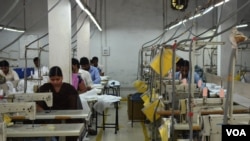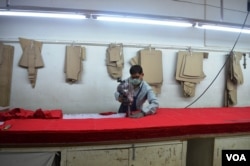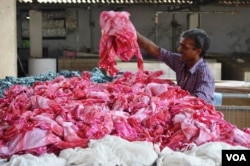South Asia can create millions of new jobs in the apparel industry by taking advantage of rising manufacturing costs in China, says a new World Bank study. This would not only boost economic growth, it would create much-needed opportunities for women.
According to the study “Stitches to Riches,” East Asian countries like Vietnam and Cambodia are capturing the market share of global garment exports faster than countries like India, Bangladesh, Pakistan and Sri Lanka.
But lower costs and a burgeoning young, working class population, give South Asia an opportunity to increase the size of its apparel industry, which continues to be labor intensive.
This is important for a region where female participation in the workforce is dismally low. The share of women employees in garment factories is far higher compared to other industries: women account for more than two-thirds of the industry’s work force in Sri Lanka, and about one-third in India and Bangladesh.
The World Bank country director in India, Onno Ruhl, said this could help countries like India. “Female labor participation unfortunately has been going down over the last 10 to 15 years, and it is a trend we would really like to see reversed in India,” he said.
According to the World Bank study, countries with greater female labor force participation generally see later marriages, fewer children, better nutrition and school enrollment and higher gross domestic product.
Wages, a key component in industry, range from about half a dollar per hour in Bangladesh to over a dollar in India. That is far lower than about $2.5 in China.
But although these jobs have improved the lives of women, working conditions in the region have come under scrutiny.
The biggest wake-up call came in 2013, when the collapse of the eight-story Rana Plaza building in Bangladesh killed more than 1,100 garment factory workers and turned the spotlight on the hazardous conditions in the industry.
Rob Wayss at the Bangladesh Accord on Fire and Building Safety, said growth opportunities in the sector will not be fully realized without a simultaneous effort to improve factories. The Accord is spearheading a safety overhaul in Bangladesh’s garment industry.
“The industry cannot grow in Bangladesh and in other parts of South Asia without close attention to safety and compliance. The global brands and global retailers are paying close attention to conditions in their factories,” he said.
The World Bank study has also underlined the need for stricter controls, better wages and higher-value products.
Ruhl is also urging India to encourage more foreign direct investment in the sector and to scale up the size of businesses from small enterprises to medium-sized ones.
The industry employs about five million workers in the formal sector, and several millions in the informal sector.











